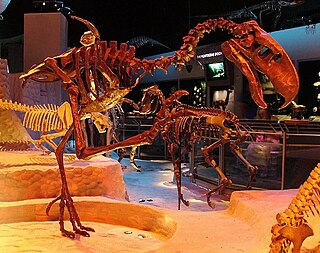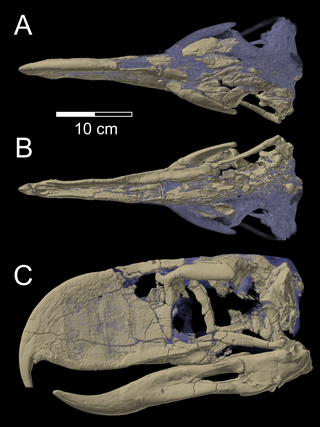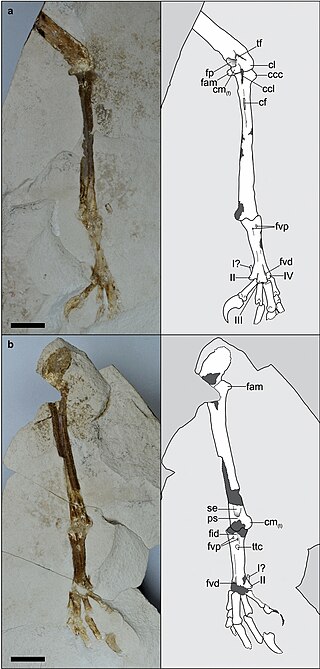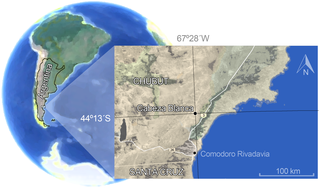
Phorusrhacids, colloquially known as terror birds, are an extinct family of large carnivorous, mostly flightless birds that were among the largest apex predators in South America during the Cenozoic era; their conventionally accepted temporal range covers from 53 to 0.1 million years (Ma) ago, and perhaps even up to 21,600 ± 1,000 years ago.

Titanis is a genus of phorusrhacid, an extinct family of large, predatory birds, in the order Cariamiformes that inhabited the United States during the Pliocene and earliest Pleistocene. The first fossils were unearthed by amateur archaeologists Benjamin Waller and Robert Allen from the Santa Fe River in Florida and were named Titanis walleri by ornithologist Pierce Brodkorb in 1963, the species name honoring Waller. The holotype material is fragmentary, consisting of only an incomplete right tarsometatarsus and phalanx, but comes from one of the largest phorusrhacid individuals known. In the years following the description, many more isolated elements have been unearthed from sites from other areas of Florida, Texas, and California. It was classified in the subfamily Phorusrhacinae, which includes some of the last and largest phorusrhacids like Devincenzia and Kelenken.

Presbyornis is an extinct genus of anseriform bird. It contains two unequivocally accepted species; the well-known P. pervetus and the much lesser-known P. isoni. P. pervetus was approximately the size and shape of a goose, but with longer legs; P. isoni, known from a few bones, was much larger, more than swan-sized. Other fossils, more doubtfully assigned to this genus, are also known.

Andalgalornis is a genus of flightless predatory birds of the extinct family Phorusrhacidae that lived in Argentina. The type and only species is A. steulleti.

Brontornis is an extinct genus of giant bird that inhabited Argentina during the Early to Middle Miocene. Its taxonomic position is highly controversial, with authors alternatively considering it to be a cariamiform, typically a phorusrhacid or an anserimorph.
Anatalavis is genus of prehistoric birds related to ducks and geese, perhaps to the magpie-goose in particular. Alternatively, it might have been a more basal lineage of Anserimorphae distinct from the living waterfowl, similar or even related to the roughly contemporary Conflicto antarcticus from the Danian of Antarctica.
Paleontology or palaeontology is the study of prehistoric life forms on Earth through the examination of plant and animal fossils. This includes the study of body fossils, tracks (ichnites), burrows, cast-off parts, fossilised feces (coprolites), palynomorphs and chemical residues. Because humans have encountered fossils for millennia, paleontology has a long history both before and after becoming formalized as a science. This article records significant discoveries and events related to paleontology that occurred or were published in the year 1969.

Devincenzia is an extinct genus of giant flightless predatory birds in the family Phorusrhacidae or "terror birds" that lived during the Early Miocene (Deseadan) Fray Bentos Formation of Uruguay, Late Miocene (Huayquerian) Ituzaingó Formation, Early Pliocene (Montehermosan) of Argentina, and possibly the Early Pleistocene Raigón Formation of Uruguay. The type species D. pozzi was formerly known as Onactornis pozzi. The largest possible specimen weighed up to 350 kilograms (770 lb), making it one of the largest phorusrhacids and carnivorous birds known.

Patagornis is a genus of extinct flightless predatory birds of the family Phorusrhacidae. Known as "terror birds", these lived in what is now Argentina during the Early and Middle Miocene; the Santa Cruz Formation in Patagonia contains numerous specimens. Patagornis was an agile, medium sized Patagornithine and was likely a pursuit predator.

Andrewsornis is an extinct genus of giant flightless predatory birds of the family Phorusrhacidae or "terror birds" that lived in Oligocene Argentina. Fossils have been found in the Sarmiento Formation, and possibly the Agua de la Piedra Formation.

Psilopterus is an extinct genus of phorusrhacid from the Middle Oligocene to possibly the Late Pleistocene of Argentina and Uruguay. Compared to other phorusrhacids, members of the genus are both relatively gracile and diminutive, and include the smallest known species of terror bird: with the head raised P. bachmanni was 70–80 centimeters (2.3–2.6 ft) in height and weighed about 5 kilograms (11 lb), while the largest members of the genus were only about 8 kilograms (18 lb). The birds resemble the modern cariama, except with a heavier build and considerably smaller wings. Fossil finds in Uruguay indicate the genus may have survived until 96,040 ± 6,300 years ago, millions of years after the larger phorusrhacids became extinct.
The Divisaderan age is a South American land mammal age, covering a period of geologic time within the Middle and Late Eocene epochs of the Paleogene. It follows the Mustersan age and is followed by the Tinguirirican age.
Cunampaia is a dubious genus of extinct mesoeucrocodylian. Fossils have been found from the Divisadero Largo Formation of Mendoza Province, Argentina, and date back to the Divisaderan to Tinguirirican regional South American Land Mammal Age of the Late Eocene epoch.

The Odontoanserae is a proposed clade that includes the family Pelagornithidae and the clade Anserimorphae. The placement of the pseudo-toothed birds in the evolutionary tree of birds has been problematic, with some supporting the placement of them near the orders Procellariformes and Pelecaniformes based on features in the sternum.
Eutreptornis is a genus of extinct possible cariamiforme bird from the Late Eocene of Utah. It is traditionally considered to be a bathornithid, though a combination of the relative incompleteness of the material alongside some differences from other bathornithids have raised some suspicions about this affiliation.

Ueekenkcoracias is an extinct genus of primobucconid bird in the order Coraciiformes from the Huitrera Formation of Patagonia. A relatively large member of the stem-Coracii, Ueekenkcoracias possessed a robust femur and stout tibiotarsus, with a strongly projected facies articularis medialis.
Dryornis, also called the Argentinian vulture, is an extinct genus of cathartid, known from Argentina. The genus contains two species, D. pampeanus and D. hatcheri.

The Sarmiento Formation, in older literature described as the Casamayor Formation, is a geological formation in Chubut Province, Argentina, in central Patagonia, which spans around 30 million years from the mid-Eocene to the early Miocene. It predominantly consists of pyroclastic deposits, which were deposited in a semi-arid environment. It is divided up into a number of members. The diverse fauna of the Sarmiento Formation, including a variety of birds, crocodilians, turtles and snakes, also includes many mammals such as South American native ungulates as well as armadillos, and caviomorph rodents.
Wunketru is an extinct genus of waterfowl from the Eocene Las Flores Formation of Chubut Province, Argentina. The genus contains a single species, W. howardae, known from a partial skeleton previously classified as a species of Telmabates.










